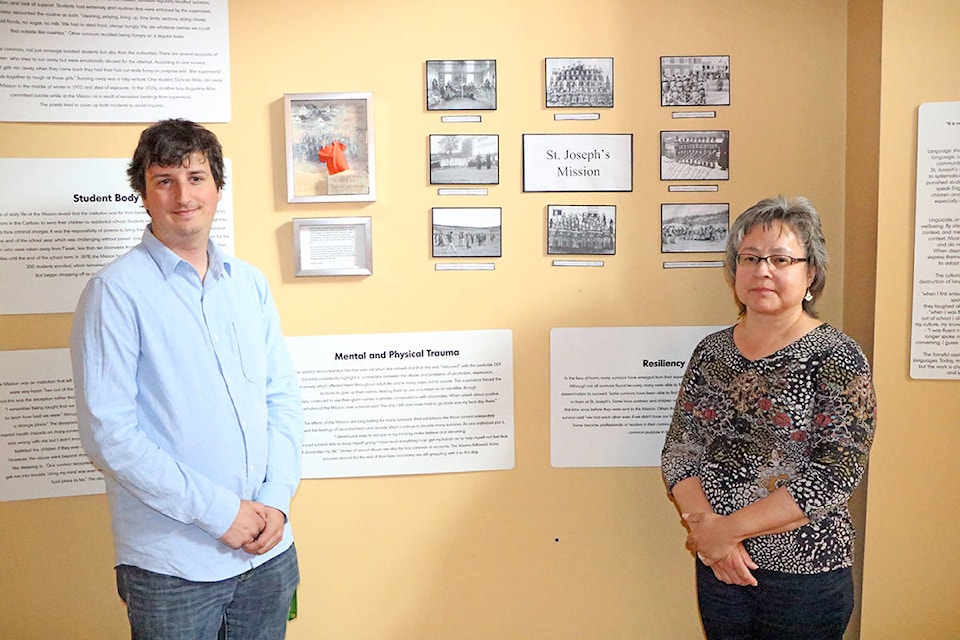The Museum of the Cariboo Chilcotin invites people to learn about the history of St. Joseph’s Mission residential school with a new exhibit.
Years after being shut down St. Joseph’s Mission residential school still casts a long shadow over the lives of many Indigenous people in and around the Williams Lake area. It was open and in operation from July 19, 1891 to June 30, 1981, just 38 years and one generation ago.
While the physical building no long remains — two monuments stand at the location in 2013 to mark the site, the Museum of the Cariboo Chilcotin’s museum coordinator, Joe Borsato, felt it was time to catalogue and remember this dark but significant chapter of Cariboo history.
Read More: Remembering, Recovering and Reconciling
Throughout the process of building the display, Borsato said it was important to listen to the accounts of residential school survivors and pair their stories with appropriate visuals, while putting St. Joseph’s Mission in the context of the national conversation going on surrounding the history of residential schools. As Williams Lake is the founding city of Orange Shirt Day, he feels this exhibit is especially important to keep this conversation going.
“We didn’t come at this from the perspective of just showing one perspective, we had 14 people or so we interviewed for this and the overwhelming response to the mission is not a positive story. We also wanted to highlight the resiliency of many of the survivors because ultimately, the fact that the mission was designed to destroy Indigenous culture the fact that it failed is one thing I really wanted to show and emphasize,” Borsato said.
This was why Borsato worked closely with Phyllis Webstad, whose story about her experience at St. Joseph’s Mission inspired Orange Shirt Day. He worked with Webstad throughout the process when it came to editing stories and collecting artifacts for the exhibit.
Webstad, who now works for the Orange Shirt Society, said this exhibit and Orange Shirt Day is part of an ongoing effort to keep the conversation around residential schools going that started with the end of the Truth and Reconciliation Commission. As a former director of the Museum of the Cariboo Chilcotin, history and culture has always been Webstad’s passion, which is why she was happy to provide support and pictures for the exhibit, as well as a good portion of the artifacts.
Despite a lot of talk about reconciliation in society and the government, Webstad said she feels that there’s not enough real public knowledge about what went on in residential schools that were “top to bottom” located across Canada. This exhibit, along with her book The Orange Shirt Story, she feels will help educate locals, tourists and Canadians in general that there was a residential school not 10 minutes from the Tourism Discovery Centre.
Read More: Indian residential schools: Canada’s sad legacy
“I’m a third generation survivor. My grandmother was the first generation, she went from 1925 to 1935. All of her 10 children were taken away and sent to residential school, including my mother who attended for 10 years. I went for one year when I was six, so my experience is a walk in the park compared to the first and second generation,” Webstad said. “I have a hard enough time talking about it and I know those that have more years than I do have an extra hard time talking about it.”
Even within their own homes and communities, Webstad said this topic is not commonly broached and many survivors never talk about their experiences, even today. There is a lot of emotion that goes with addressing this chapter in survivors’ lives and part of the reason many don’t talk about it today is the coping mechanism they developed while there.
Webstad said her aunt told her that when they were at St. Joseph’s Mission, they were all in the same boat and there was no use crying or talking about it. When they went home for the two months a year, she said they wanted to be happy rather than cry and talk about what they were going through. Addressing these emotions now she said is difficult and every survivor is at a different point in their journey.
For example, September is a particularly difficult time for residential school survivors, as that was the time the children left their families and returned to school.
Every little bit to educate people, however, helps Webstad said. In addition to this exhibit and her story, residential school history is now a part of the curriculum in all B.C. public schools and in many provinces across Canada.
“Any kind of understanding and help we can get to spread this word, we need allies, First Nations people can’t do all of this ourselves. This is not just First Nations’ history, this is Canadian history and the onus is on everyone to know and to understand,” Webstad said.
Webstad wanted to thank Borsato for his work on putting the exhibit together and the amount of listening he did when interviewing community members.
Borsato would like to thank all the community members who contributed or donated artifacts to the exhibit. He said he is still looking for and interested in any artifacts from the mission, though they need to be able to be traced directly back to St. Joseph’s here in the Cariboo.
He also wanted to thank the Heritage Legacy Fund, the Central Cariboo Arts and Culture Society, the City of Williams Lake and the Cariboo Regional District for helping to fund and support the project.
patrick.davies@wltribune.com
Like us on Facebook and follow us on Twitter
